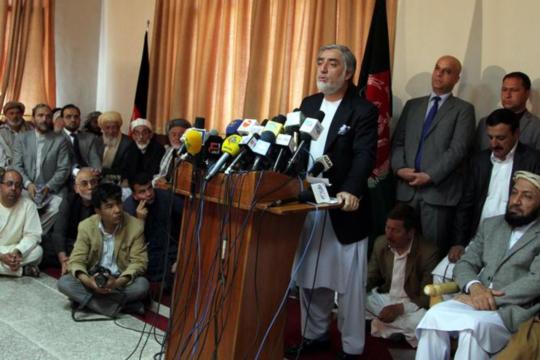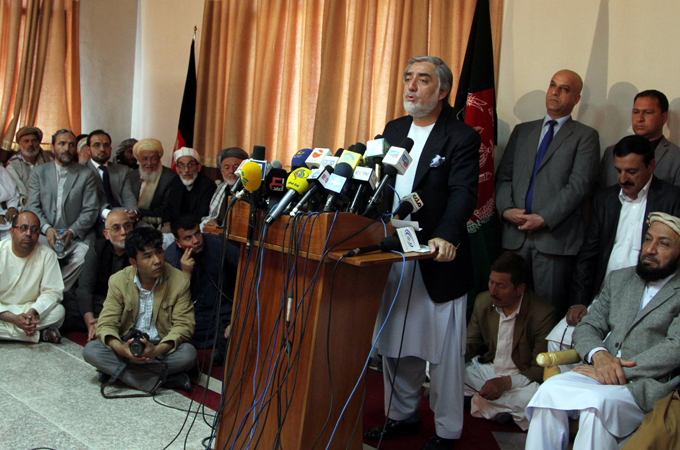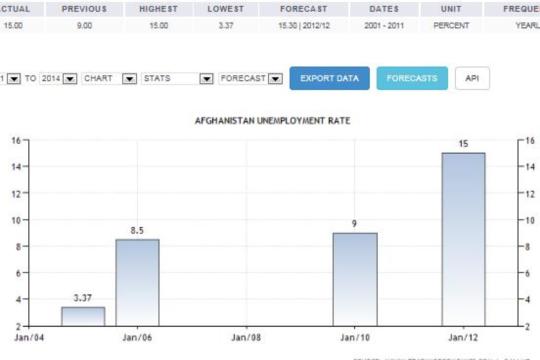
 |
| Afghan Presidential candidate Dr. Abdullah Abdullah speaks to supporters during a gathering in Kabul, Afghanistan [EPA] |
| Abstract After twelve years, the Afghan president, Hamid Karzai, is about to leave the Arg, the Afghan presidential palace and a new administration is set to take over. Indeed, Karzai did not have an easy task, especially since he assumed office after the dark era of Taliban dominance. Nevertheless, more than a decade later, and after investing enormous amounts of money, Karzai’s regime did not achieve all that it was expected to. Hence, the new administration will have the formidable task of carrying Karzai’s burden, and of addressing urgent national matters sooner rather than later. |
Introduction
Over the past few decades, Afghanistan underwent several transformations. Nonetheless, 5 April 2014 was exceptional in that it marked the first ‘peaceful’ transition of power through electoral means. (1) But the new government will shoulder the huge responsibility of moving the country forward, despite Afghanistan’s fragile political and economic situation. Since 2001, when he assumed power from Burhanuddin Rabbani, the former Afghan president who was assassinated by the Taliban in 2011, Karzai has headed the Afghan administration. Since the Soviet invasion in 1979, the country has been in turmoil. During the invasion, Afghans were relatively unified in claiming their independence from the invaders, but following the Soviet withdrawal in 1989, the so-called Civil War broke out, forcing millions of Afghans to leave the county, and thousands of lives were lost to bloodshed. Although jihad against the Soviet invasion was regarded as Islamic resistance, the aftermath of intra-Afghan fighting over power during the early 1990s destroyed much of the country. In order to comprehend the current socio-political reality of Afghanistan, it is critical to examine these incidents in greater depth. It is also necessary to analyse the expectations of the Afghan people, and the challenges that will be faced by the newly elected government.
A glance at Afghanistan before Karzai
Before the Soviet invasion in the early 1980s, fragmentations among Afghans were already suggesting the possibility of clashes. At the time, the social conflict had two ingredients, both of which hold true in the current circumstances. First, there were clashes between those who sought an Islamic state and those who upheld a more liberal and socialist regime. This dichotomy was strengthened by the fact that Iran, on Afghanistan’s western border, had just transformed and put into place a radical Islamist Shi’a government. Second, something of a cold war had already existed between different ethnic groups. Until then, Afghanistan had been strongly influenced by its tribal leaders, and had barely practised any representational system. Throughout its history, the country had been ruled in a decentralised form, which gave adequate autonomy to local authorities. Misra asserts that ‘Afghanistan remained primarily an authoritarian monarchy for most of its history and the reach of the central government was tenuous in the outlying areas, as a matter of expediency various regimes and ruling houses allowed regional autonomy that often coincided with ethnic or tribal autonomy.’ (2) This factor is significant when we analyse the political structure of Afghanistan, and examine how certain individuals exert influence in the bigger political decision-making process.
The post-Soviet chaos raised numerous historical tensions, especially regarding the two matters of the political system, and ethno-tribal representation within it. These tensions were inevitable in a country that had not been exposed to a democratic and representational system. Demographically speaking, the country is home to several ethnicities, including the Hazaras, Tajiks, Turkmens, and Pashtuns. (3) The civil war during the early 1990s reflected the manoeuvrings of these ethnic groups and the fervent desire of each one to rule the country. However, the years of civil war had created fertile ground for domestic and external subversive forces to intervene, resulting in the emergence of the Taliban. (4)
Taliban or (Afghanistan in Medieval Era)
The Taliban era was one of ‘total war’ when the country not only suffered extensive infrastructural damage, but when the foundations of the country’s economy, education, culture and international affairs were also debilitated. During the Taliban’s reign all institutions were tailored to a narrow Taliban perspective, which was essentially an amalgamation of Pashtun tribal law with Shari’ah laws. The regime not only failed to receive recognition from the international community – apart from Pakistan, the United Arab Emirates and Saudi Arabia – but it was also extremely unpopular domestically, especially among moderate Muslims and ethnic minorities. The Taliban’s legitimacy and popularity deteriorated even further when it sheltered members of al-Qa’ida, including Osama bin Laden. The regime patently promoted its historical, linguistic, and ideological values over others. Although the initial ‘ethnic conflict’ had begun during the civil war, it had not become pronounced until the Taliban imposed its extremist Islamic doctrine and cultural Pashtun values. After the 9/11 tragedy in the USA, the world paid closer attention to Afghanistan, after having neglected it for more than a decade. With the help of the international community, Afghans, mostly led by the Northern Alliance, overthrew the Taliban and established an interim government. In short, the new administration had to begin from scratch to reconstruct and reunite the country, which was an impossible task without the assistance of the international community.
Karzai and his legacy
Although some credit should be given to the coalition government of Hamid Karzai for having brought all political stakeholders in the country to the table, his administration failed to deliver a coherent plan and system for government. His ‘edging policy’ towards the Taliban, and his often contradictory stances on the social and political affairs of citizens were very unpopular. His popularity has only waned with time. Karzai’s policies were not only paradoxical domestically, but have also occasionally perplexed Afghanistan’s neighbours and his western allies. For instance, a few days before the recent elections, Karzai asserted that the war over the past twelve years was fought for the Americans and for their interests, thus angering the West. (5) His comments also enraged domestic politicians, and the local media, who furiously pointed to numerous Taliban attacks on Afghan civilians, including women and children, which had nothing with the US presence. At another time, Karzai refused to sign a security agreement despite the fact that the Loya Jirga (Council of Elders) had voted for the agreement. Nonetheless, Karzai’s efforts to lead the country and prepare it for an election cannot be dismissed as futile, even if his twelve-year administration leaves behind domestic and foreign policies riddled with contradictions which will present a great challenge for the new government.
The new president’s ‘to do list’
Regardless of who will be elected as the new president, his challenges will be numerous, and he will have to deal with them sooner rather than later. Of these, there are three that are most crucial. The first and the most important will be the question of security, since there is unanimity that the Taliban insurgency has strengthened over the last few years. Taliban guerrilla warfare and suicide attacks have reached even the safest areas in Afghanistan. The Afghan Tolonews reported, ‘In the last two years alone, more than 820 people were killed and 2,866 more were injured in Taliban-claimed suicide attacks.’ (6)
The return of the Taliban in some parts of the country is due to several factors. First and foremost, the central government is absent in many parts of the country, and the resulting power vacuum provides an opportunity for the Taliban to assume an overseer role in these remote villages and cities. Also, the presence of western troops in Afghanistan has increased opposition to the central government, especially in the eastern provinces. The Taliban has used the large number of civilian causalities as a tool to mobilise people against the government. Many Afghans, especially in the rural areas, are conservative, and the Taliban has used this factor to mobilise some groups against the foreign troops and the central government. The new government faces a dilemma: should it sign the security agreement with the United States, which will allow the Americans to remain in Afghanistan after the original withdrawal date, or should it risk attempting to secure the country on its own with the currently ill-equipped and ill-trained domestic security forces. As suggested by the Iraqi experience, securing peace after a war in torn and fragmented countries has proven to be a daunting task. Therefore, it would be wise for the new government to sign the agreement.

The second challenge is the economic factor, which has had a definite impact on security matters as well. Unemployment tripled between 2002 and 2011, as found it increasingly difficult to find suitable employment. (7) Research by the UNDP shows that around seventy per cent of Afghans are under the age of twenty-five, (8) suggesting firstly that this age group makes up a huge chunk of the consumer sector, and, secondly, that there is the emergence of a generation that will be able to help drive the economy. In 2013, more than 255,000 young Afghan boys and girls graduated from high school, but only forty per cent of them were able to proceed to higher education institutions. Thus, approximately 150,000 are not in tertiary institutions. Many young educated Afghans have been employed by non-governmental organisations, but there is a fear that, following the US withdrawal from the country, many of these NGOs will close down negatively impacting on the employment prospects of many Afghans. The new government will also have a huge task to try attract more foreign direct investment (FDI), and to encourage public-private partnerships. FDI can, at least in more secure areas such as Herat, Mazar-e Sharif and Bamiyan, advance the crippled economy, and, more importantly, create the jobs which young Afghans desperately need. The government will also need to encourage Afghan businesspeople to participate in public projects, especially in the education and healthcare sectors.
The third, equally important, task for the new government will be to create a sense of common identity for its citizens, to uphold values that represent the general will of the people, while paying attention to the particularities of different sectors of the population. This is a significant task that Karzai’s government failed to address; instead, it sought simply to homogenise all Afghans, despite key social and cultural differences between various ethnic groups. It is essential that all citizens of Afghanistan feel that they are represented, and this requires the future government to lay the foundation of a national identity that is not based on tribal affiliations, but on the will of the people to move forward to rebuild the country.
The identity crisis in Afghanistan can be viewed from two angles. At a micro level, ethnic affiliations are often allotted greater value than national pride. Many minorities believe that the government does not represent their ethnicities, an argument that is exacerbated when the political elites discuss official languages, a national anthem, personal identification cards and so forth. Many minorities raised their voices on social media platforms when the Karzai administration decided to omit ‘ethnicity’ from the new identification cards. The second threat to a cohesive national identity is external. Most television channels, textbooks, and other socio-cultural influences originate mainly in Iran, India and Pakistan. For example, many young Afghans imitate Bollywood actors’ dress. These influences are concerning, especially in the long term, for a country with one of the highest illiteracy rates in the world. Hence, the new government has the formidable task to create a new mindset for a new generation of Afghans who will not only represent them all, but also protect Afghan culture from foreign influences.
Several other challenges also face the newly established state. Will the Afghans be able to stand on their own feet, if the Americans do completely withdraw? Will the Taliban agree to compromise their core values and join a democratic state? And above all, will the new generation of Afghanistan again resort to arms if the Taliban return as they did in the mid-nineties? None of these questions can be answered with certainty; the answers will depend on unfolding developments in the near future. What is clear, however, is that the people of Afghanistan hope for peace, and that the recent election was a vivid example of their commitment.
_____________________________________________________________
Copyright © 2014 Al Jazeera Center for Studies, All rights reserved.
*Safiullah Taye is young Afghan who is currently living in Doha. He is currently pursuing an Executive Master in Energy and Resources at HBKU. He attended Georgetown University and acquired a degree in International Politics and Arab and Regional Studies.
Endnotes:
1) Rod Nordland and Mathew Rosenberg, 2014. ‘After ’09 Fraud, Afghanistan Reports a Cleaner Election’, New York Times, 8 April, http://www.nytimes.com/2014/04/09/world/asia/number-of-election-complaints-almost-nothing-afghanistan-says.html.
2) Amalendu Misra, 2004. Afghanistan: The Labyrinth of Violence. New York: Polity, 42.
3) Library of Congress, 2014. ‘A Country Study: Afghanistan’, The Library of Congress: Country Studies, Federal Research Division: Library of Congress, 10 April.
4) Neamatollah Nojumi, 2002. The rise of the Taliban in Afghanistan: mass mobilization, civil war, and the future of the region. New York: Palgrave.
5) Al Jazeera, 2014. ‘Karzai says US troops can leave Afghanistan’, 15 March, http://www.aljazeera.com/news/middleeast/2014/03/karzai-says-us-troops-can-leave-afghanistan-2014315133323437829.html.
6) Anisa Shahid, 2013. ‘Special Report: Taliban Suicide Bombings in Review’, 5 July, http://www.tolonews.com/en/afghanistan/11100-special-report-taliban-suicide-bombings-in-review.
7) See http://www.tradingeconomics.com/afghanistan/unemployment-rate.
8) UNDP, 2009. ‘National Joint Youth Programme (NJYP)’, April,
http://www.undp.org.af/whoweare/undpinafghanistan/Projects/dcse/prj_youth.htm.